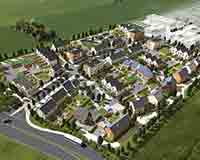 Garden cities pioneer Sir Ebenezer Howard would surely be surprised to discover that title being applied, a century after he built Letchworth and Welwyn, to four urban extensions in Bicester and a vast former quarry in Kent.Co
Garden cities pioneer Sir Ebenezer Howard would surely be surprised to discover that title being applied, a century after he built Letchworth and Welwyn, to four urban extensions in Bicester and a vast former quarry in Kent.Co
Politicians have latched onto the idea of standalone, self-sustaining garden cities to provide new homes without the usual aggravation from voters that arises from building in existing towns – the name also sounds more appealing than “new town”. So far, only Bicester (main picture) and Ebbsfleet have been designated as garden cities, and neither is quite what it seems.
Howard’s self-contained, low-density “land hungry” garden cities were replete with greenery and open space. But Bicester’s garden city title simply lumps together urban extensions already in various stages of development.
Meanwhile, Ebbsfleet was touted as a new settlement as long ago as the Bluewater retail complex’s completion in the adjacent abandoned chalk quarry in 1999.
Plans came and went with little progress until the first homes were started last year.
The main difference garden city status has made to both is the prospect of a sympathetic hearing for government infrastructure funding bids.
Bicester is a fast-growing town, 12 miles from Oxford and close to the M40 motorway, with a direct train line to London.
Government support will see £55m for developers’ finance and £44m for infrastructure.
Private housebuilders are providing 2,500 homes south-west of the town of Kingsmere, on land taken through planning and servicing by Countryside Properties.
In north-west Bicester, 6,000 homes are being built by social landlord A2 Dominion, based on plans approved under the former eco-towns programme.
 Meanwhile, Graven Hill is a 1,900-home self-build project promoted by Cherwell district council, and in south-east Bicester there is an undeveloped site capable of taking 1,500 homes.
Meanwhile, Graven Hill is a 1,900-home self-build project promoted by Cherwell district council, and in south-east Bicester there is an undeveloped site capable of taking 1,500 homes.
Cherwell’s team leader for major developments, Jenny Barker, explains: “The extensions will increase the town’s population from 30,000 to 50,000, adding 12,000 homes.
“The council will bid to the government for road improvements, health and education infrastructure and a motorway junction.”
A2 Dominion’s regional director of development Gerry Walker is leading the development of north-west Bicester, where around 3,000 homes should be completed by 2031.
“The garden city designation has not made much difference as the plan is that of the eco-town, which we will still develop with local employment, lots of open space, 30% affordable housing and zero carbon standards,” he says. “The exemplar project is already on site for 393 homes.”
Andrew Carrington, Countryside’s strategic land division’s managing director, says designation has not made a significant difference at Kingsmere, where it has sold on serviced land packages to six builders, as Countryside was already there.
He does, however, see advantages in the name, which suggests a “landscape-led environment that people will not view as just being ‘anywhere’ development, so it may help with perceptions”.
Graven Hill is self-build on a scale not previously seen in the UK, and one of Cherwell’s motives was to secure the resulting skills training opportunities for local people.
“The council is optimistic there will be sufficient interest,” says Barker. “It’s expected to range from people who buy a plot to design their own home to small groups building affordable housing.
“Steps will be taken to ensure delivery is supported so we do not end up with 1,900 half-built homes.”
Why develop at Bicester? Carrington says: “The location is good, as you can get to London or Birmingham easily, and in value terms it is a lot cheaper than Oxford. On some estimations it’s one of the fastest-growing towns in Europe.”
Better motorway links will be vital, he says: “The infrastructure funding is important as the M40 can be slow with shoppers at peak times and it needs a better link for the town to thrive.”
A2 Dominion’s Walker says much of Oxfordshire is “quite unaffordable, but Bicester is very strategically placed with room to grow, while prices tend to be lower than the surrounding area”.
Barton Willmore senior planning partner Iain Painting, who provided A2 Dominion’s masterplan, says: “Our plans draw on Welwyn and Letchworth.
“It’s a self-sustaining community in which there must be job opportunities within a sustainable travelling distance, so it’s not just a big suburb.
“There will be a lot of green space – 40% of the surface area – and half of that publicly accessible.”
Painting defends garden cities as “the way to go if we don’t want to just keep building 150,000 or so homes a year”. But he believes that “the state has to be involved in land assembly and ensuring infrastructure is there. You cannot leave this up to district councils to provide the land”.
Conrad Payne, a partner in Strutt & Parker’s national residential planning team, believes garden city status may help projects get off the ground if it means the government will kick-start infrastructure, which is a huge outlay for housebuilders.
He says: “The biggest blockage to building homes is that the government needs to resource local authority planning departments. That would do more to get homes built than designating garden cities.”
The Ebbsfleet development was stymied by the recession after Land Securities bought it 10 years ago.
The government is creating a garden city urban development corporation (UDC), backed by £200m of public investment, to cover the company’s Eastern Quarry, the area around the Eurostar station – jointly owned by LandSec and Lafarge Tarmac – and the latter’s Swanscombe Peninsula, the possible site of the Paramount Park entertainment complex.
Ward Homes is building the first 150 homes of 1,500 in Eastern Quarry’s Castle Hill village, with 4,500 homes planned for another two villages.
A LandSec spokesman says: “We have spent tens-of-millions on site preparation and we’re selling packages to housebuilders.
“By the end of 2015 we hope to have builders for at least half of Castle Hill.”
LandSec hopes the corporation will accelerate development to eventually get 15,000 homes across the three sites. The spokesman adds: “The UDC can be a single planning authority, provide infrastructure and de-risk development.”
Will Cousins, chairman of planning consultant David Lock Associates, first worked at Ebbsfleet in the 1990s. “In Ebbsfleet, the model is that the landowner and the UDC will need to share the risk and reward,” he says.
“If it works, there are potentially dozens of locations around the country where this arrangement can be deployed to accelerate homebuilding where large sites are too indigestible for the average land developer or volume housebuilder.”
CBRE’s head of UK research, Miles Gibson, expects any government involving Labour and/or the Liberal Democrats to pursue their enthusiasm for garden cities, although a Conservative majority would be more cautious, given its preference for localism in planning.
“Garden cities should be one option and, given the scale of the housing crisis, it would be wrong to take any option off the table,” he says.
Bicester and Ebbsfleet may succeed, but such unusual factors attend both that neither is really a trial of the stand-alone garden city concept.
Welwyn and Letchworth garden cities were built by Sir Ebenezer Howard in the early 20th century, and still offer his intended sense of space and greenery.
Colin Haigh, head of planning at Welwyn Hatfield borough council, has to deal with an expanding town with a large conservation area at its heart.
“We have an estate management scheme that dictates what can happen there, but it does not always chime well with changes in the planning system,” he says.
The council must build to a higher density than Howard’s 12 homes per acre to meet demand, and so tries to adapt his principles to modern conditions.
Haigh says: “The Arts and Crafts architecture can look a bit twee now so we encourage developers and architects to update it.”











